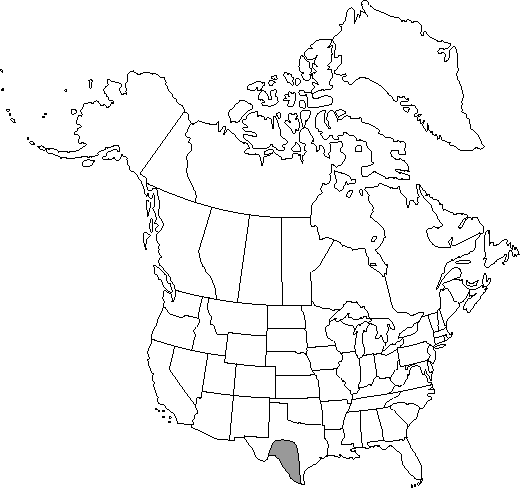Difference between revisions of "Ephedra pedunculata"
Proc. Amer. Acad. Arts 18: 157. 1883.
FNA>Volume Importer |
FNA>Volume Importer |
||
| Line 17: | Line 17: | ||
}}<!-- | }}<!-- | ||
| − | --><span class="statement" id="st- | + | --><span class="statement" id="st-undefined" data-properties=""><b>Shrubs </b>vinelike, trailing or clambering, 6–7 m. <b>Bark</b> gray, slightly cracked and fissured. <b>Branches</b> alternate (rarely whorled), lax, angle of divergence about 55°. <b>Twigs</b> gray-green, becoming green, then yellow-green with age, glaucous, with several moderately deep longitudinal grooves; internodes 1–8 cm. <b>Terminal</b> buds attenuate, 1–3 mm. <b>Leaves</b> opposite, 1–3 mm, connate to 2/3–7/8 their length; bases splitting at margins, persistent; apex obtuse. <b>Pollen</b> cones 1–2 at node, lanceoloid, 4–8 mm, sessile or on short to long, smooth peduncles; bracts opposite, 6–12 pairs, light yellow to reddish, obovate, 2–4 × 2–3 mm, membranous, free or slightly connate at base; bracteoles barely exceeding bracts; sporangiophores 3–5 mm, exserted to 1/2 their length, with 4–6 long-stalked (1–2 mm) microsporangia. <b>Seed</b> cones 1–2 at node, ovoid, 6–10 mm, on short to long, smooth peduncles; bracts opposite, 3–6 pairs, 3–4 × 2–3 mm, ovate, connate to 1/8–7/8 their length, inner pairs becoming succulent and red when ripe. <b>Seeds</b> 2, ellipsoid, 4–10 × 2–4 mm, brown, smooth.</span><!-- |
-->{{Treatment/Body | -->{{Treatment/Body | ||
| + | |phenology=Coning midwinter–early spring. | ||
|habitat=Dry, sandy to rocky areas and slopes | |habitat=Dry, sandy to rocky areas and slopes | ||
|elevation=100–1000 m | |elevation=100–1000 m | ||
| Line 39: | Line 40: | ||
|basionyms= | |basionyms= | ||
|family=Ephedraceae | |family=Ephedraceae | ||
| + | |phenology=Coning midwinter–early spring. | ||
|habitat=Dry, sandy to rocky areas and slopes | |habitat=Dry, sandy to rocky areas and slopes | ||
|elevation=100–1000 m | |elevation=100–1000 m | ||
| Line 46: | Line 48: | ||
|publication year=1883 | |publication year=1883 | ||
|special status= | |special status= | ||
| − | |source xml=https://jpend@bitbucket.org/aafc-mbb/fna- | + | |source xml=https://jpend@bitbucket.org/aafc-mbb/fna-data-curation.git/src/9216fc802291cd3df363fd52122300479582ede7/coarse_grained_fna_xml/V2/V2_543.xml |
|genus=Ephedra | |genus=Ephedra | ||
|species=Ephedra pedunculata | |species=Ephedra pedunculata | ||
| − | |||
| − | |||
| − | |||
| − | |||
| − | |||
| − | |||
| − | |||
| − | |||
| − | |||
| − | |||
| − | |||
| − | |||
| − | |||
| − | |||
| − | |||
| − | |||
| − | |||
| − | |||
| − | |||
| − | |||
| − | |||
| − | |||
| − | |||
| − | |||
| − | |||
| − | |||
| − | |||
| − | |||
| − | |||
| − | |||
| − | |||
| − | |||
| − | |||
| − | |||
| − | |||
| − | |||
| − | |||
| − | |||
| − | |||
| − | |||
| − | |||
| − | |||
| − | |||
| − | |||
| − | |||
| − | |||
| − | |||
| − | |||
| − | |||
| − | |||
| − | |||
| − | |||
| − | |||
}}<!-- | }}<!-- | ||
-->[[Category:Treatment]][[Category:Ephedra]] | -->[[Category:Treatment]][[Category:Ephedra]] | ||
Revision as of 13:23, 27 July 2019
Shrubs vinelike, trailing or clambering, 6–7 m. Bark gray, slightly cracked and fissured. Branches alternate (rarely whorled), lax, angle of divergence about 55°. Twigs gray-green, becoming green, then yellow-green with age, glaucous, with several moderately deep longitudinal grooves; internodes 1–8 cm. Terminal buds attenuate, 1–3 mm. Leaves opposite, 1–3 mm, connate to 2/3–7/8 their length; bases splitting at margins, persistent; apex obtuse. Pollen cones 1–2 at node, lanceoloid, 4–8 mm, sessile or on short to long, smooth peduncles; bracts opposite, 6–12 pairs, light yellow to reddish, obovate, 2–4 × 2–3 mm, membranous, free or slightly connate at base; bracteoles barely exceeding bracts; sporangiophores 3–5 mm, exserted to 1/2 their length, with 4–6 long-stalked (1–2 mm) microsporangia. Seed cones 1–2 at node, ovoid, 6–10 mm, on short to long, smooth peduncles; bracts opposite, 3–6 pairs, 3–4 × 2–3 mm, ovate, connate to 1/8–7/8 their length, inner pairs becoming succulent and red when ripe. Seeds 2, ellipsoid, 4–10 × 2–4 mm, brown, smooth.
Phenology: Coning midwinter–early spring.
Habitat: Dry, sandy to rocky areas and slopes
Elevation: 100–1000 m
Distribution

Tex., n Mexico.
Discussion
Of conservation concern.
Selected References
None.